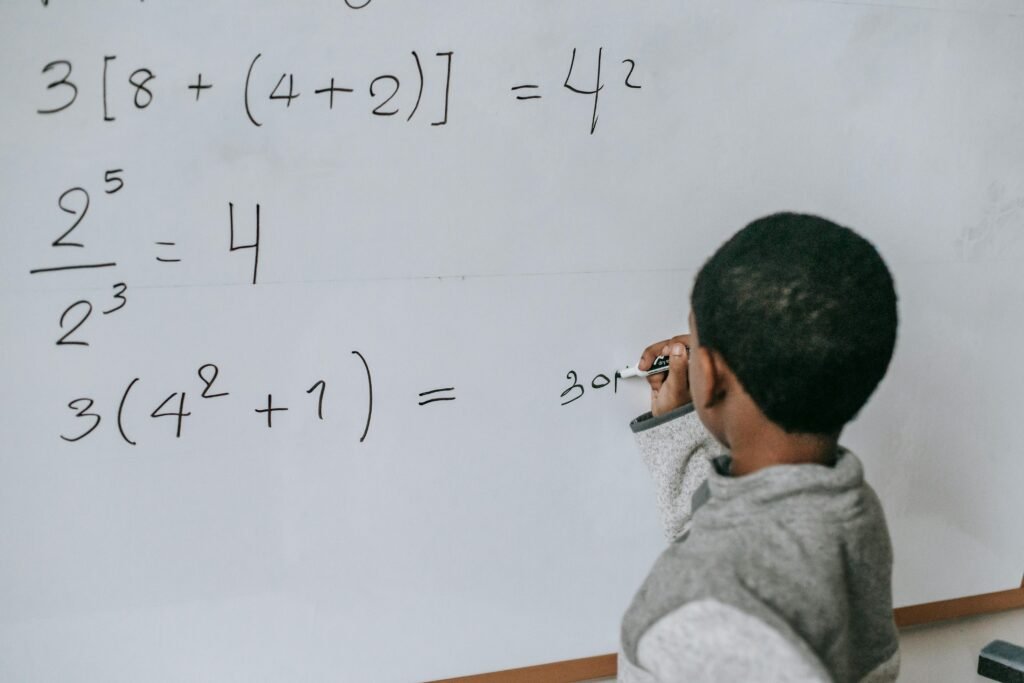We live in a screen-first world. Kids, teens, and even adults do almost everything on a device. Learning, reading, writing, and even doodling have moved from paper to screens. But here’s the big question—does this shift help us remember better, or are we forgetting more than ever?
1. Students who handwrite notes retain 30% more information than those who type them
This stat says a lot, doesn’t it? If students who use a pen and paper remember 30% more than those typing on a laptop, that’s not just a little edge—it’s a big one. Imagine getting almost one-third more information to stick in your brain, just by changing how you write.
But why does this happen?
When you write by hand, your brain works harder to decide what to put down. You can’t write every word someone says—you have to listen, think, and then write the most important parts. That extra thinking helps your brain lock in the ideas. You’re not just copying; you’re learning as you go.
On the other hand, typing is fast. It’s so fast that many students type word for word without even thinking. It feels productive, but your brain is not fully engaged. It’s like eating fast food—you feel full, but you don’t get the good stuff.
So what can you do about it?
If you’re a student, try switching to handwritten notes, even if it’s just for one subject. Use a notebook with wide lines so writing doesn’t feel cramped. Don’t worry about making it perfect—this is for you, not anyone else. After class, take five minutes to read over your notes. You’ll start to see things stick better.
If you’re a parent, encourage your child to write things down with pen and paper. Buy fun notebooks, colorful pens, or even stickers to make it feel more exciting. Show them how to create their own little “note book of genius.”
If you’re a teacher, give short lectures where students must write a summary by hand at the end. Don’t collect it. Just have them do it for themselves. You’ll start to notice they remember more and need less repetition.
Retention is not just about memory—it’s about how we interact with information. Handwriting forces your brain to make choices. Those choices lead to deeper understanding. And when kids understand, they grow.
2. Typing notes results in more verbatim transcription, reducing cognitive processing
Let’s talk about that word—verbatim. It means writing things down word-for-word. When students type notes, they often try to capture every single thing the teacher says. It sounds like a good thing, but it actually slows down learning.
Why? Because when you type every word, you’re not thinking about what the words mean. You’re just copying. And copying is not the same as understanding.
Now compare that to handwriting. Since you can’t write every word quickly, your brain has to process what’s being said. You have to stop and think, “What’s the big idea here?” That mental pause is powerful. It’s in that pause that learning happens.
Cognitive processing is your brain’s way of organizing information. It helps you make sense of ideas, connect new facts to old ones, and remember things for the long term. Typing skips that step too often. It turns your brain into a recorder, not a thinker.
So what can we do?
If you must use a laptop, try summarizing what you hear instead of typing everything. Write one sentence for every five the teacher says. That way, you’re still listening, but your brain is staying active. Another good trick? Close your laptop every 10 minutes and write down the main points on paper. Even a few minutes of handwriting can boost your memory.
Teachers can help by giving cues like, “This is a big idea,” or, “Write this in your own words.” These little signals encourage students to engage, not just copy.
Parents, if your child is doing homework on a screen, have them keep a “memory notebook” beside them. Ask them to jot down what they just learned in their own words. It doesn’t have to be fancy. Just the act of slowing down and writing helps build better thinkers.
Verbatim notes might feel safe, but they don’t help much when the test comes. Active thinking beats fast typing every time.
3. Handwriting engages more brain regions related to memory and learning
This stat goes deep—literally into the brain. When scientists study how our brains work during handwriting, they find that many areas light up at once. Not just the parts that move your hands, but also areas for memory, attention, and understanding.
Typing, on the other hand, doesn’t light up the brain in the same way. It uses fewer regions. It’s like turning on one light in a room instead of flipping on all the switches.
When kids write by hand, they’re building brain strength. It’s like giving their brain a full workout instead of just one exercise. And the more parts of the brain that are involved, the more likely it is that information will be remembered later.
But here’s the beautiful part—this doesn’t just help in school. It builds brain habits that carry into life. Better memory, better focus, and better problem-solving. These are skills that last far beyond the classroom.
So what should you do?
Students should start small. Just spend 10 minutes a day writing notes, journaling, or copying something they’re learning. It could be vocabulary, math steps, or even science facts. The goal is to engage the brain, not just fill the page.
Teachers can add short writing breaks into their lessons. Even two minutes of handwritten thinking can boost learning. Ask questions like, “What did you just learn?” or “What does this remind you of?” and have students write their answers.
Parents, encourage activities that use handwriting. Let your child write a letter, draw and label a diagram, or create flashcards. These brain-boosting habits build focus and memory without screens.
When more parts of the brain are active, more learning sticks. And in a world full of distractions, that’s something every student needs.
4. Handwritten note-takers score 10–15% higher on conceptual understanding tests
Conceptual understanding is all about knowing the “why,” not just the “what.” It’s one thing to memorize a math formula. It’s another to know why that formula works. That deeper level of learning is called conceptual understanding—and handwritten notes seem to help a lot with it.
In fact, students who write by hand often score 10 to 15% higher on tests that measure how well they understand the ideas behind the facts. That’s not just a few extra points—it could be the difference between a B and an A, or even between passing and failing.
Why is that?
When you handwrite, you naturally summarize, rephrase, and connect ideas. These are all higher-level thinking skills. You’re not just taking notes—you’re learning as you go. Your brain is working to make sense of the material, which leads to deeper understanding.
Typing, however, doesn’t encourage this as much. It’s easier to zone out while copying long sentences. Even when you look back at typed notes later, they’re often long and messy, filled with too much information and too little meaning.
So how can students level up their learning?
Try taking notes using a method called “Explain It to a Friend.” After class, write a short summary as if you were teaching it to someone else. Use your own words, and keep it simple. You’ll quickly find out if you understand the concept or if you just copied it.
Teachers can support this by giving open-ended questions during class. Instead of “What did I just say?” ask, “Why does this work?” or “What would happen if…?” These types of questions push students to connect ideas—not just remember them.
Parents can help at home by asking their kids to “teach” them what they learned that day. When a child explains a lesson out loud, they usually remember it better. It also gives parents a chance to cheer them on and build their confidence.
Understanding is everything. And the simple act of writing by hand can make that understanding stick.
5. Laptop note-takers recall 25% fewer facts a week later compared to handwritten
Here’s something that surprises many students: even if typed notes seem clearer or more organized, they don’t help you remember as much. In fact, studies show that students who use laptops to take notes remember 25% fewer facts just one week later.

That’s a big deal.
Think about how much work students put into studying. They show up to class, sit through lessons, and try to do well on tests. But if they’re forgetting a quarter of the information just because of how they took notes, that’s a huge missed opportunity.
What’s happening here?
It goes back to the difference between copying and thinking. Laptops let you type fast, which means you’re often just recording, not engaging. You might capture more words, but fewer of those words end up in your memory.
When you write by hand, it’s slower. But that slowness is good. It forces you to think, rephrase, and make connections. And that’s what helps your brain hold onto facts long after the lesson is over.
So what can students do to boost their memory?
Start with a weekly review routine. Every weekend, go back over the week’s handwritten notes. Don’t just read them—rewrite the most important ideas in a fresh way. Try making a mini summary page. This extra layer of processing locks in the facts and helps you remember more when you need it most.
Teachers can help by building in review days. Even five minutes at the end of class to go back over the notes and pull out key ideas makes a big difference. This doesn’t just help students remember more—it shows them how to study smarter.
Parents, support your child by setting up a weekly “study moment.” Maybe it’s Sunday morning at the kitchen table. Ask your child to show you the three biggest things they learned that week. When they explain it out loud or draw it out by hand, they’re also helping their brain keep it longer.
Remembering 25% more—or less—can be the difference between struggling and succeeding. And the tool that makes that difference? A simple pen and paper.
6. Handwriting activates the reticular activating system (RAS), improving attention
Let’s talk about a fancy term: the reticular activating system, or RAS for short. This is a part of your brain that controls alertness and attention. Think of it like a spotlight. When your RAS is turned on, your brain says, “Hey, pay attention! This matters!”
Here’s the cool part: handwriting turns on the RAS. Typing? Not so much.
When you write by hand, your brain treats it like a special task. It brings in your motor skills, visual tracking, memory, and more. All of this sends a message to the RAS: “We’re learning something important here.” That helps your brain stay alert and focused.
In contrast, typing can feel passive. Your fingers move fast, but your brain might be half-asleep. You might be listening to the teacher, but also thinking about your next class, or what’s for lunch. The RAS isn’t fully engaged, and attention slips away.
So how can we use this to our advantage?
Students should treat handwriting like a brain warm-up. Before class starts, try writing down a few goals for the day by hand. It could be as simple as, “Listen closely” or “Understand the new math rule.” This small habit turns on your RAS early and sets your brain up to focus.
During class, take short breaks to pause and write a question or reflection by hand. Just one sentence can bring your attention back to the lesson.
Teachers can support this by building “handwriting checkpoints” into lessons. After a big idea, ask students to write what they just learned in one sentence. Not only does this boost memory—it resets their focus.
Parents can build RAS-friendly habits at home too. Before homework, have your child write a simple to-do list by hand. Let them check things off as they go. This helps them stay focused and gives them a little boost of confidence.
In a world full of screens, attention is rare. But with a pen, paper, and a little help from the RAS, students can train their brain to stay sharp.
7. Digital devices reduce focus time by up to 60% due to multitasking
We all know how distracting screens can be. One moment you’re typing notes, the next you’re checking a message, switching tabs, or clicking on a pop-up. When students take notes on digital devices, it’s way too easy to get pulled in a hundred directions. And according to research, all that switching cuts focus time by up to 60%.
That’s a huge drop.
Think about it—if a student can only focus for 40% of a lesson, they’re missing more than half of what they’re supposed to learn. It’s not because they’re lazy or don’t care. It’s because the tool they’re using is built to distract.
Handwriting does the opposite. It anchors you. There are no tabs, no alerts, and no apps on a notebook. Just you, your pen, and your thoughts. That quiet space gives your brain room to breathe, focus, and learn without interruption.
So how do we beat digital distractions?
If you’re a student and need to use a device for class, try using “Do Not Disturb” mode. Close all tabs that aren’t part of the lesson. Better yet, leave your phone in another room or in your backpack where you can’t reach it easily.
Even better, use paper for note-taking during class. Then later, you can type them up for neatness or sharing if needed. That way, you get the focus benefits of handwriting, and the organization benefits of digital.
Teachers can help by creating tech-free zones during certain parts of the lesson. Say, “Let’s do this next part on paper.” It’s a simple switch, but it sets the tone for deeper focus.
Parents, create a homework space that’s low-tech. Use timers for focused work sessions—say 25 minutes of pure focus, followed by a short break. And try to model the same habits yourself. Kids notice when you’re also focused.
Multitasking sounds like a skill, but when it comes to learning, it’s actually a trap. Handwriting brings students back to single-tasking—and that’s where the real learning lives.
8. Children who learn to write by hand show faster neural development than those who type
This one is for the younger learners out there. When children first start writing by hand, their brains go through big changes. Studies show that kids who use handwriting develop neural pathways for thinking, memory, and reading faster than kids who start out typing.
Why is that?
Writing by hand is a complex task. It requires your brain to control small muscles, recognize shapes, form letters, and think about what you’re trying to say—all at the same time. That kind of mental work helps grow and strengthen the brain, especially in early years.
Typing skips a lot of that. It focuses on hitting keys, which takes less brain effort. You don’t need to know how a letter is formed—you just need to know where it is on the keyboard. It’s faster, yes, but not better for growing brains.
This is why handwriting is especially important in early learning.
So what can we do?
If you’re a parent of a young child, give them lots of chances to write by hand—even if it’s just scribbles or shapes. Let them draw letters in the sand, trace words with crayons, or use fun pens to make their own name signs. These small actions build big brain power.
Teachers in early grades should keep handwriting practice a daily routine. Don’t rush to laptops too soon. Even five minutes of letter tracing and writing words by hand can support stronger reading, better spelling, and sharper thinking.
Older students can still benefit too. If your child started with typing and struggles with memory or focus, try going back to basics. Handwriting flashcards, vocabulary notebooks, or drawing out diagrams by hand can jumpstart new learning pathways.
Handwriting doesn’t just help kids learn letters. It helps build the brain itself. And in a world racing toward screens, that’s something worth slowing down for.
9. In a study, students using handwritten notes retained over 80% of lecture content after one week
Let’s pause on this one. Over 80% retention a week later? That’s almost unheard of in most learning situations. But it’s exactly what happened in a study where students used handwritten notes instead of typed ones.
Why does this work?
It all comes down to active processing. When students write things down by hand, they’re not just repeating words—they’re choosing what to write, deciding how to say it, and making mental links as they go. That triple process turns short-term memory into long-term knowledge.
Typed notes, on the other hand, often stay in short-term memory. You might remember things for the day, or even a test—but a week later? Gone. The brain didn’t get the message that this was worth keeping.
So what can we learn from this?
Students should aim for more than just passing a test. If you want knowledge that sticks, write it down. After class, instead of just reading over your notes, test yourself. Cover the page and try to write everything you remember from memory. Then compare and fill in the gaps. Do this once a week and you’ll remember far more with far less study time.
Teachers can build this into their routine. Give a quick “pop recall” session every Friday. Ask students to pull out a blank page and write down everything they remember from that week’s topics—no peeking. Then let them review their notes to see what they missed.

Parents can also turn this into a game. Call it “Memory Master.” Ask your child to teach you what they learned that week using only their memory. You’ll be amazed at what sticks—and what doesn’t.
The goal isn’t to fill notebooks. It’s to build brains. And handwritten notes, when used right, are one of the best tools we have.
10. Typing can produce more words per minute, but not deeper understanding
There’s no doubt about it—typing is fast. In fact, most people can type at least twice as many words per minute as they can write by hand. That speed feels great when you’re trying to keep up in a lecture or get through homework quickly.
But here’s the problem: more words doesn’t mean more understanding.
Typing often leads to automatic writing. Your fingers move, but your brain may not be keeping up. You might be typing full sentences without really thinking about what they mean. That’s especially true during fast-paced lectures or online classes.
With handwriting, you can’t go as fast—and that’s actually a good thing. The slower pace gives your brain a chance to think. You end up writing less, but what you do write tends to be more thoughtful, more organized, and easier to remember later.
So how do you strike the right balance?
Students who like typing should consider using it after the class—not during. Take rough notes by hand first. Then, type them up later while reviewing the material. That way, you get the benefit of both methods. You’ll write thoughtfully and review while you type.
Teachers can encourage this by giving a few minutes at the end of lessons to handwrite a summary. This helps balance the fast pace of technology with the deep processing of handwriting.
Parents, remind your kids that writing less doesn’t mean learning less. In fact, sometimes the less you write, the more you think. Help them focus on quality over quantity when it comes to note-taking.
Typing may be fast, but understanding takes time. And in learning, depth matters more than speed.
11. Writing by hand improves symbol recognition and spatial awareness
Writing isn’t just about letters and words. It’s also about shapes, spaces, and symbols. When you write something down by hand—like a math equation, a diagram, or a foreign character—your brain learns how it looks, where it fits on the page, and what it means. That’s what we call symbol recognition and spatial awareness.
Handwriting trains your brain to notice details. You pay attention to how a “b” is different from a “d,” where to place a decimal, or how one line of a diagram connects to another. That spatial understanding helps you remember not just the content, but how it was organized—where it lived on the page.
Typing flattens all of that.
When you type, every letter looks the same. Each line stacks on top of the next. There’s no physical memory of shape or space. You’re not drawing—you’re tapping.
So what does that mean for learning?
For subjects like math, science, and languages, handwriting gives you a big edge. Writing formulas by hand helps you remember their structure. Drawing cells or systems builds connections in your mind. Copying characters in a new language helps you understand them better than just seeing them on a screen.
Students can use this by drawing more. When learning something new, don’t just write the words—sketch a simple diagram. Make a little chart. Use arrows, bubbles, or even doodles. These tiny drawings make your brain work harder—and smarter.
Teachers can encourage visual note-taking. Ask students to make concept maps or draw simple symbols that represent ideas. It’s a great way to bring deeper thinking into the classroom.
Parents, give your kids plain paper for homework, not just lined notebooks. Let them spread ideas out. Some kids love using different colors to organize their thinking visually—and that’s actually a powerful learning tool.
Handwriting gives your brain a picture. And when you can see what you’re learning, you’re more likely to remember it.
12. Handwritten notes result in twice the recall compared to typing during open-book tests
This one might be the most convincing of all—twice the recall during an open-book test. That’s not just a little boost. That’s a learning superpower.
In studies, students who took handwritten notes were able to remember twice as much information when using their notes during an open-book test. They found what they needed faster. They remembered where to look. They even understood the context better.
Why? Because handwritten notes create a stronger mental map.
When you write things by hand, you remember where on the page you put that diagram, what color you used for that keyword, or how you grouped certain ideas together. Your brain stores these visual and physical cues alongside the actual content.
Typing doesn’t leave those same memory markers. Notes typed in a document often blur together. Everything looks uniform. You end up scrolling and scanning, which takes time and leaves you feeling lost.
Here’s how to use this to your advantage:
Students, take time to make your handwritten notes your own. Use headings, highlight key facts, and leave some space between ideas. When it’s time for an open-book test or review, you’ll move through your notes quickly and confidently—because they’ll make sense to you.
Teachers, before a big quiz or test, give a practice open-book session. Encourage students to bring their handwritten notes and show them how much easier it is to work through the material. The more they see the value, the more they’ll want to do it.
Parents, help your child color-code their notes or use symbols for key ideas. Simple changes—like a red star for “important!”—can help them recall faster when it counts.
Open-book doesn’t mean easy. You still have to remember what to look for. And handwriting helps make those memories stronger.
13. Longhand note-taking improves working memory performance by over 25%
Working memory is like your brain’s notepad. It helps you hold onto information just long enough to use it—like remembering a phone number until you dial it, or keeping part of a sentence in mind while writing the rest.
Handwriting gives this part of your brain a serious boost—over 25% better performance.
Why is this so important?
Because working memory isn’t just used in school. It’s part of everyday life. It helps you stay focused, solve problems, follow instructions, and even manage emotions. Kids (and adults!) with stronger working memory tend to be more organized, more confident, and less overwhelmed.
When you write by hand, your brain actively juggles ideas. You think about what was just said, what it means, and how to write it. That’s a workout for working memory. And just like a muscle, the more you use it, the stronger it gets.
Typing skips some of that effort. You can zone out and still type. The brain doesn’t have to juggle ideas in the same way, and the “memory muscles” don’t grow as much.
Here’s what to do:
Students, challenge yourself with handwriting “memory bursts.” After reading a section of your textbook, close it and write down everything you remember. Then go back and check. This helps strengthen working memory and makes studying more effective.

Teachers can give mini challenges like “write what you just learned in three steps” or “draw a flowchart from memory.” These short activities build memory while also reviewing content.
Parents, support brain-boosting games at home. Even simple tasks like writing out the steps to make a sandwich or directions to the park help kids use their working memory. And if they do it by hand, the benefits are even stronger.
Your brain’s notepad is small—but powerful. And handwriting is one of the best ways to keep it sharp.
14. Students using laptops are more likely to check social media during lectures
We all know what happens when students take notes on laptops. Even if they start off focused, it doesn’t take long before curiosity kicks in. One quick peek at social media turns into five minutes lost—and that five minutes could hold the most important part of the lesson.
Studies show that students using laptops are far more likely to open social media, messaging apps, or unrelated websites during class. Once that distraction kicks in, it’s hard to get back on track.
Why is this such a big deal?
Because attention isn’t just about staying still. It’s about staying mentally present. If your brain leaves the room—even for a few seconds—it misses things. And those gaps are hard to fill in later.
Handwriting removes that temptation. You can’t scroll through Instagram on a notebook. The fewer distractions you have, the more learning you keep.
So what should we do?
Students, be honest with yourself. If you know you’re tempted to open apps during class, switch to handwriting for at least one or two subjects. You’ll stay focused, and your brain will thank you.
Teachers can create “device-free” days or zones. Let students experience what it feels like to be fully present. Many will notice right away that they understand the material better when screens are off.
Parents, help your child create focus habits. During homework time, ask them to leave their phone in a different room. Use music or timers to build a peaceful work zone that feels rewarding—not restrictive.
It’s not about banning technology. It’s about knowing when it helps, and when it hurts. And during note-taking, handwriting is often the smarter choice.
15. Multitasking on screens while note-taking lowers test scores by 11%
Here’s a stat that might surprise some people—11% lower test scores just because of multitasking. That means two students could sit through the same class, learn the same material, and study for the same test… but the one who multitasked on their device might score a whole letter grade lower.
That’s no small thing.
Multitasking feels productive. Switching between notes and Google, or checking a quick message, doesn’t seem like a big deal. But every switch takes your brain a few seconds—or even minutes—to get back on track. That adds up fast.
When you’re constantly jumping between tasks, you don’t process anything deeply. You might “kind of” get it in the moment, but it slips away fast. And when test day comes, your brain draws a blank.
Handwriting helps stop that. When you write by hand, you’re doing one thing. Your brain is focused. And that single-tasking is powerful.
What can you do about it?
Students, try setting a rule: one task at a time. During class, focus only on notes. After class, then look things up. If you really need to Google something mid-class, write it in the margin as a question and come back to it later. This helps keep your brain in flow.
Teachers can talk openly about the danger of multitasking. Show the research. Let students experiment with device-free study and see the difference it makes in their own scores.
Parents, if your child is multitasking during homework, gently guide them back to focus. Use sticky notes or a whiteboard to write down off-task thoughts—like “text Sara back” or “check that video later.” This keeps their brain clear, without making them feel controlled.
Learning is a full-brain activity. Multitasking turns that brain into a traffic jam. But handwriting clears the road.
16. Handwritten notes result in 40% more concept connections than typed notes
Understanding facts is one thing. But making connections between ideas is what real learning is all about. That’s what helps students move from memorizing to mastering.
When students write by hand, studies show they make 40% more concept connections than those who type. That means they’re not just listing facts—they’re seeing how those facts fit together, how one idea leads to another, and what it all means in the bigger picture.
This happens because handwriting gives your brain more time and space to reflect. You’re not rushing. You’re thinking as you write, which invites your mind to look for patterns, compare ideas, and make links.
Typing doesn’t always allow for this deeper reflection. You’re moving fast, trying to keep up, and not leaving much mental space to think beyond the surface.
So how can you encourage concept connections?
Students, try adding a “Why does this matter?” question after each section of notes. Pause and write the answer in your own words. Another great tip is to draw arrows or little diagrams that show how ideas connect. Even a simple “Idea A ➜ Idea B” line helps.
Teachers can use graphic organizers or mind maps in lessons. These tools are perfect for helping students see how one topic connects to others. And when students fill them out by hand, the connections become even stronger.
Parents, ask questions that make your child think deeper. Instead of “What did you learn today?” ask “How is that connected to what you learned last week?” Help them build a mental web of knowledge—not just a list of facts.
Learning isn’t just about what you know. It’s about how well you connect what you know. And handwriting is a secret tool for doing just that.
17. Laptop users are twice as likely to report feeling distracted during lectures
Let’s be honest—many students feel distracted during lectures. But research shows that students using laptops are twice as likely to say they feel unfocused or restless during class.
That’s a serious problem, especially in today’s world where so much learning happens online or in blended classrooms. Even the most motivated student can get pulled into distractions when a device is in front of them.
Part of the issue is the illusion of productivity. When you’re typing quickly or switching between slides and notes, it feels like you’re doing a lot. But if your brain isn’t locked in, it’s just noise.
Handwriting helps cut through that. There are no pop-ups on paper. No tabs to flip through. No messages dinging in the corner of your screen. It’s quiet focus, and it feels different.
So what can students do?
Try a few classes with just a notebook. See how you feel afterward. Was it easier to pay attention? Did the time go faster? Did the lesson feel clearer? Most students are surprised by how much more “in the moment” they feel without a screen in front of them.
Teachers can encourage this by starting with short “paper-only” parts of class. Even 10 minutes of handwritten reflection or note-taking can reset focus and help students feel more grounded.
Parents, help your child notice their focus habits. After homework or study time, ask: “Did anything keep pulling your attention away?” If the answer is yes, try switching to handwriting for one subject at a time and see how it helps.

Focus isn’t just about willpower. It’s also about the tools we use. And sometimes, the simplest tool—pen and paper—is the most powerful one.
18. Typed notes are 40% more likely to be verbatim, lowering synthesis skills
We’ve talked about verbatim notes before, but it’s worth repeating because the impact is huge. Typed notes are 40% more likely to be word-for-word copies of what the teacher said. That sounds okay at first—until you realize it actually harms your ability to synthesize, or make sense of the information.
Synthesis means taking different pieces of information and putting them together in a new way. It’s one of the highest-level thinking skills. It’s what you do when you write essays, solve real-world problems, or explain a complex idea simply.
When students type everything the teacher says, they’re skipping the step where synthesis happens. There’s no need to choose what’s important or how to phrase it differently. The brain just records and moves on.
With handwriting, that doesn’t happen. You have to listen, process, and then decide how to write it. That process is synthesis—and it’s one of the reasons handwritten note-takers perform better on higher-level thinking tasks.
So how can we build synthesis?
Students should practice paraphrasing. Write down what the teacher says—but in your own words. After class, go back and add a “Why is this important?” comment next to each point. That helps you connect the pieces.
Teachers can give prompts like, “Explain this idea as if you’re teaching it to a younger student,” or “How would you use this concept in real life?” These help students move from repeating to thinking.
Parents, during homework time, ask your child to explain a lesson using a simple drawing or short story. These creative ways of showing understanding help build synthesis in a natural way.
Synthesis is where real learning lives. And handwritten notes are one of the best ways to get there.
19. Students retain more visual information when drawing or writing diagrams by hand
Ever wonder why you remember something better after you’ve drawn it out? That’s because drawing, especially by hand, boosts visual memory in a powerful way. When students write diagrams or visuals by hand, they remember more—and longer.
This goes for all kinds of subjects: math, science, geography, even language arts. When you draw a food chain, a cell diagram, a map, or a story timeline, your brain stores the picture with the idea. And those mental images are strong anchors for memory.
Typing doesn’t give you the same benefit. Even if you insert a picture into your notes, you’re still looking at someone else’s visual. When you draw it yourself, you’re creating the image—and that’s what makes it stick.
So what can students do?
When you’re studying, draw more. Even if you’re not an artist, try making stick figure diagrams or simple charts. The act of drawing helps the brain encode the information. You don’t need to be perfect—just try.
Teachers, add drawing time to your lessons. Instead of giving students pre-made graphics, have them draw their own. Whether it’s a math flowchart or a historical timeline, drawing turns the brain on in new ways.
Parents, provide materials for sketching during homework. A sketchpad, colored pencils, or even just a stack of scrap paper can turn study time into creative time—and boost retention while having fun.
Seeing is believing—and remembering. And drawing by hand helps your brain see the big picture clearly.
20. On average, students remember 20–30% more details with handwritten review notes
Let’s say you’ve already taken your notes. Now it’s time to review them. What’s the best way?
Research says that handwritten review notes help students remember 20–30% more details than digital ones. That’s a big win—especially before a test.
Why does this work? Because reviewing by hand forces your brain to slow down. You’re not just skimming a screen. You’re re-writing, organizing, and thinking. This active review tells your brain, “Hey, this is important.” And your memory listens.
Typed notes make it easier to scan—but easier isn’t always better. You may feel like you reviewed a lot, but the facts don’t stick as well. The physical act of handwriting seems to trigger deeper thinking and stronger memory.
So how do you make this part of your study routine?
Students, pick one day each week for “review and rewrite.” Look at your notes, then make a one-page handwritten summary. Use different headings, draw small visuals, and highlight key facts. This helps your brain sort and store the information.
Teachers, give students time in class to review and rewrite notes by hand. Just 10 minutes at the end of the week can boost retention—and help students feel more prepared for what’s ahead.
Parents, encourage your kids to use index cards or a review notebook. The process of copying key points by hand—even just once—can make a huge difference in what they remember during a test.
Review is where learning locks in. And when you use handwriting to do it, you get more memory for every minute you spend.
21. 85% of students report better understanding when reviewing handwritten notes
This is one of the clearest signs that handwriting works: 85% of students say they understand their lessons better when they go back and read notes they wrote by hand.
That says something powerful—not just about memory, but about clarity.
Handwritten notes are often more personal. They include margin doodles, little arrows, underlines, and things circled for attention. These aren’t just decorations—they’re brain cues. They remind you what mattered, what felt confusing, and what clicked in the moment.
Typed notes may be neater, but they’re not always clearer. They don’t always reflect how you were thinking or feeling when you wrote them.
Students, if you find yourself rereading digital notes and still feeling confused, try switching. Write your summaries or practice questions by hand. Use symbols and spacing to highlight what you need to focus on. You’ll probably find that things make more sense the second time around.
Teachers can ask students how they review their notes—and then guide them in better techniques. One tip: after any lesson, give one minute for students to write a short “What did I just learn?” reflection. These become gold during revision.
Parents, sit with your child and ask them to explain their notes out loud. If they get stuck, ask, “Would this make more sense if you wrote it differently?” That simple question can open the door to stronger review habits.
Better understanding doesn’t come from more notes. It comes from better notes—and handwriting helps make that happen.
22. Handwriting boosts neuroplasticity, helping long-term memory formation
Here’s a brainy word that matters a lot: neuroplasticity. It means your brain’s ability to change and grow. When you learn something new, your brain forms new connections. The more you repeat and reflect, the stronger those pathways become.
Handwriting is a powerful tool for boosting neuroplasticity. Every time you write something by hand, you’re strengthening your memory networks. You’re not just learning—you’re building your brain.
Typing doesn’t have the same impact. It skips some of the motor planning and feedback that handwriting requires. That means fewer brain pathways get activated.

Long-term memory is the goal for all learning. You don’t want your child to just remember something for a test. You want it to stick for life.
Students, think of handwriting as exercise for your brain. The more you write it, the more your brain keeps it. Use notebooks for tricky topics—like formulas, new vocabulary, or dates. Write it out again and again until it feels natural.
Teachers, add a “Write to Remember” section into your lessons. Let students pick one fact or idea to copy multiple times, then connect it to something they already know. This simple act can lock in long-term memory.
Parents, use repetition with handwriting at home. Flashcards, practice tests, even writing spelling words in funny colors—it all builds memory. Let your child be creative, but keep the pen moving.
Brains aren’t born smart—they’re trained to be. And handwriting is one of the best trainers around.
23. Students using pen and paper score 17% higher on post-lecture quizzes
A 17% boost in quiz scores just from switching to pen and paper? That’s massive. For many students, that’s the difference between struggling and succeeding.
When students use laptops during class, they may take more notes, but they often don’t process those notes as deeply. With handwriting, you’re already engaging with the content. You’ve thought about it, shortened it, and written it in a way that makes sense to you.
So when the quiz comes—whether it’s a pop quiz or a planned one—your brain isn’t scrambling. It already knows what to look for.
Students, if you want better quiz results, start using a notebook during lectures. Don’t worry if it’s messy. Just make it make sense to you. That personal touch helps you recall faster.
Teachers, share this stat with your students. Let them try a week of handwritten notes, then compare their quiz scores. Once they see the difference, many will make the switch without being told.
Parents, encourage your kids to do “quick quizzes” at home based on handwritten notes. Even 5-minute review sessions using paper notes can turn into real confidence boosters before the real thing.
Grades aren’t everything—but they do matter. And handwriting might just be the quiet key to lifting them higher.
24. Typing notes leads to shallower cognitive encoding
Let’s break that down. Cognitive encoding is how your brain stores information. If it encodes something well, it’s easy to recall later. If the encoding is shallow, the memory fades fast.
Typing often leads to shallow encoding. That’s because the brain isn’t working as hard to understand what’s being typed. You’re capturing, not thinking.
Handwriting, though, makes the brain slow down and reflect. You have to decide what matters, how to phrase it, and how to lay it out. That means the encoding is deeper—and deeper encoding leads to better recall.
So what should students do?
Try writing notes by hand during class, and then reviewing them later by covering them and rewriting from memory. This two-step process strengthens encoding and helps build long-term knowledge.
Teachers can support deeper encoding with writing prompts. Ask questions like, “What’s the most important thing you learned today?” or “How does today’s topic connect to yesterday’s?” These help students reflect—not just record.
Parents, if your child is studying for a test, ask them to write out everything they remember on a blank sheet. Then let them check and correct. This helps encode the material more deeply than just reading it over and over.
Memory is only as strong as the first impression. And handwritten notes make that impression stick.
25. Brain scans show stronger activity in memory-related areas when writing by hand
Here’s something amazing—when researchers look at brain scans, they see that writing by hand activates more memory-related areas of the brain than typing. It’s visible proof that handwriting lights up your mind in a way typing doesn’t.
These areas include parts of the brain involved in language, visual processing, motor control, and—most importantly—memory. When you write something down, your brain builds a stronger, more vivid memory trace. That makes it easier to retrieve later.
It’s like handwriting leaves a “footprint” in your brain, while typing barely leaves a mark.
Students can use this by writing study notes, summaries, and practice problems by hand. The physical movement helps your brain hold on to the idea longer—and more clearly.
Teachers can encourage “brain-based learning” activities that include movement, drawing, and writing. The more ways students interact with information, the more deeply it gets stored.
Parents, try using handwriting for tricky subjects. If your child has trouble remembering something, have them write it down three times, say it aloud, and draw a quick symbol for it. These layered actions activate memory in a big way.
Brains love movement—and handwriting is the perfect kind of movement for memory.
26. 70% of students who switch from digital to handwritten notes report better grades
This one comes straight from the students themselves. When students switch from typing to handwriting their notes, 70% say their grades go up.
That’s a strong signal that the method matters.
Many students don’t even realize how much they’re missing until they try something different. They assume more notes = better learning. But when they slow down, engage more, and reflect while writing, they start to own the knowledge—and their performance improves.
Students, if you feel like you’re stuck at the same grade no matter how hard you study, try switching your method. Even just one subject written by hand could make a difference.
Teachers, give students a choice but explain the benefits. Let them test both methods and reflect on how each one affects their performance.
Parents, track grades and study habits together. If your child is using a laptop and struggling, gently encourage a switch. Start small—just handwritten vocab or summaries—and see what changes.
Grades are the result of habits. And handwriting is one habit that’s easy to build—and hard to beat.
27. Handwriting enhances motor memory, aiding information retention
Motor memory is the memory of movement—like how you know how to tie your shoes or ride a bike. When you write something by hand, you create a motor pattern for that idea. Your hand movement becomes part of the memory.
That’s why many people remember things better when they physically write them down.
Typing doesn’t create the same motor pattern. Every key is pressed the same way. But with handwriting, every letter, shape, and diagram requires a specific motion—and that motion helps reinforce the idea.
Students, if you’re learning something new, write it out. Whether it’s times tables, spelling, formulas, or facts—writing helps the memory settle in your body, not just your head.
Teachers can support motor learning by adding short writing bursts into lessons. Even copying a quote, diagram, or key sentence can engage this memory pathway.
Parents, if your child has trouble remembering certain things, try a “write it five times” approach. It’s not about punishment—it’s about creating a rhythm the brain and body can remember together.
Your hands remember more than you think. And when they write, your mind follows.
28. Typed notes reduce note personalization, which affects memory retrieval cues
One of the hidden benefits of handwriting is how personal it becomes. You underline certain words, draw stars, use different sizes or colors, and make little arrows to connect ideas.
These personal touches become memory cues. When you look back at your notes, you remember not just what you wrote—but how you felt about it, where it was on the page, and what you were thinking at the time.
Typed notes are cleaner, but they’re also flatter. Everything looks the same. There are fewer personal memory hooks, and that makes recall harder.
Students, take time to make your notes your own. Use boxes, shapes, colors, or symbols. Even adding emojis or tiny sketches can make your notes more memorable.
Teachers can encourage creativity by asking students to decorate their notes in a way that makes sense to them. This also helps students take pride in their work.
Parents, let your child experiment with different ways of note-taking. Not every kid learns the same. Help them discover a style that sticks.
Memory isn’t just about information—it’s about meaning. And personalized notes are full of meaning.
29. Children taught handwriting early show better reading fluency
Handwriting and reading go hand in hand. Research shows that kids who learn to write letters by hand early on also become more fluent readers.
Why? Because writing helps the brain learn the shape, sound, and meaning of letters in a deep way. It turns the alphabet into something you feel, not just see. And that builds strong reading foundations.
Typing doesn’t build that same fluency. It’s too disconnected. You press a button, and the letter appears. There’s no motor memory, no shape tracing, and no strong mental link.
Students in early grades benefit hugely from daily handwriting. It strengthens their letter-sound connections, builds confidence, and helps them move from “sounding out” to smooth reading.
Teachers, keep handwriting alive—even in tech-rich classrooms. A few minutes of writing practice each day adds up.
Parents, encourage your child to write grocery lists, birthday cards, or signs for their room. These small tasks help build big reading skills.
Reading starts with writing. And the earlier, the better.
30. Handwriting helps improve focus and mindfulness, reducing anxiety during studying
Finally, here’s a benefit that touches the heart: handwriting doesn’t just help you learn better—it helps you feel better. Students who write by hand often report lower stress, more focus, and a calmer mind during study time.
That’s because handwriting is mindful. It slows you down. It brings your thoughts into the present moment. And when you feel more in control, you feel less anxious.
Typing often feels rushed. It can make studying feel like a race. But with handwriting, it’s easier to breathe, think, and absorb information in a way that feels manageable.
Students, try writing your study plan or to-do list by hand before you start working. It helps your brain settle. If you’re feeling overwhelmed, pause and journal for five minutes—just a quiet way to clear your thoughts.

Teachers, create quiet writing moments in your classroom. Even one minute of silent handwriting can help students calm down and reset their focus.
Parents, build a calm study space with notebooks, pens, and peaceful energy. Encourage handwriting as a way to slow down and reconnect with learning.
In a noisy world, handwriting is quiet. But its impact is loud—and lasting.
Conclusion
We live in a world where screens are everywhere. From classrooms to living rooms, most learning now happens on keyboards, tablets, and phones. And while technology has its place, we must not forget the simple, powerful act of writing by hand.



